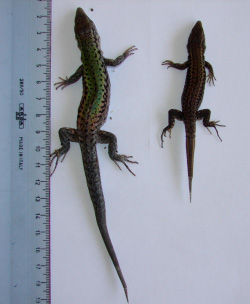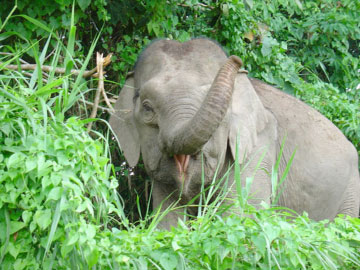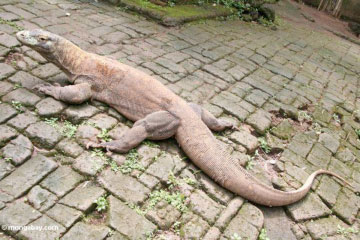From the terrifying Komodo dragon to the diminutive hobbit Homo floresiensis, islands are home to some remarkable curiosities of size. Despite the fame of giant lizards and pygmy humans, a longstanding tenet of evolutionary biology suggests that the size of island animals moves towards the middle of the pack. A study published on 1 September in the Journal of Biogeography explores these two seemingly contradictory notions and finds that neither is a perfect explanation.
 Giant and normal Skyros Wall Lizards. Plentiful food may have set the stage for gigantism in populations of Skyros wall lizards (left) that live on small islets near Skyros, the home of the smaller lizard (right). Image by: Panayiotis Pafilis. |
Animals on islands have fewer competitors to fight with over resources, and islands often lack large carnivorous predators. Some scientists point to these features as drivers of the evolution of extreme body size. For example, perhaps large flightless birds evolved on islands because there was no pressure for predators to maintain a stealthy stature. But island life is not always easy—resources on islands are more limited than on continents. Mix a scarcity of resources with less competition and fewer predators and you have a recipe for the “island rule.” This rule suggests that with limited resources, large-bodied animals will evolve to be smaller, and without predators, small-bodied animals will evolve to be larger.
To explore whether island life marches toward size extremes or towards a middle ground, a team led by zoologist Shai Meiri of Tel Aviv University studied an extensive dataset of hundreds of living and extinct lizards, birds, and mammals. The team counted the number of groups for which either the largest or smallest species was island-dwelling and asked whether the observed frequencies were higher than expected by chance.
 The pygmy elephant of Borneo. Borneo’s pygmy Asian elephants grow to around 8 feet (2.5 m) tall, while their mainland counterparts typically reach almost 10 feet (3 m). Image credit: amanderson2 on flickr.com |
The researchers found no surplus of extremely large or small mammals on islands. However, mammals did, in part, follow the island rule. Large body lineages, likes elephants, tend to evolve to smaller sizes on islands. “The forces keeping them large on the mainland, competition and predation, are probably weaker on islands, allowing dwarfism,” Meiri told mongabay.com by email. Nonetheless, the scientists found no tendency for small mammals to become bigger.
In lizards and birds, the authors found no evidence for the island rule. They did find, however, that more islanders were the largest members of their groups than would be expected at random. For example, for 9 out of 19 lizard groups, the Godzilla of the bunch was an island dweller. With no mammalian predators, island lizards may evolve into the role of large predators.
 The Komodo dragon is an island giant. The Komodo dragons of Indonesia are the largest lizards on earth. Image by: Rhett Butler, mongabay.com |
The study is “the most thorough exploration of the topic so far,” said John Welch of Cambridge University in an interview with mongabay.com. Welch, who has also studied patterns of body size evolution, lauded the thoroughness of the data and tests. “Others have drawn similar conclusions, but often on much weaker grounds,” said Welch.
Island ecology isn’t enough to explain every evolutionary oddity of island-dwelling species. Resource abundance, predation, and competition all vary among islands. The evolution of body size is “contingent on the ecological settings of different islands and the biological properties of particular animals,” said Meiri. There is no “mysterious mystical property of islands,” he added.
CITATION: Shai Meiri, Pasquale Raia and Albert Phillimore. Slaying dragons: limited evidence for unusual body size evolution on islands. Journal of Biogeography. http://dx.doi.org/10.1111/j.1365-2699.2010.02390.x
Susan Young is a graduate student in the Science Communication Program at the University of California, Santa Cruz.